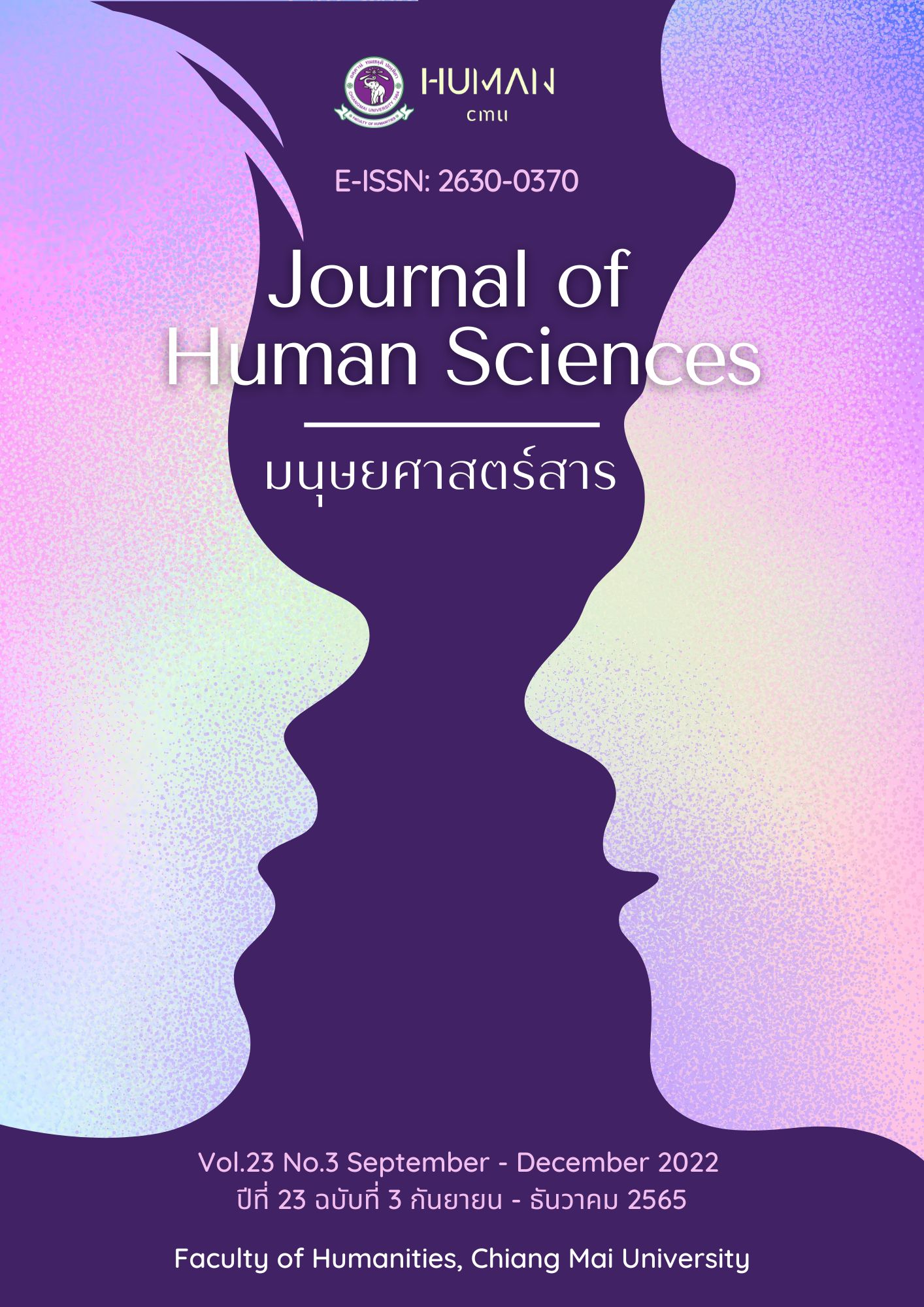การ ศึกษาภูมิทัศน์ภาษาศาสตร์ของเสื้อยืดบนเพจเฟสบุ๊คในประเทศไทย
Main Article Content
บทคัดย่อ
งานวิจัยนี้พัฒนาจากคำกล่าวของคลอด์เวลล์ (2017) ที่ว่า เสื้อยืดสามารถสื่อความในลักษณะเดียวกับป้ายในภูมิทัศน์ภาษาศาสตร์ งานวิจัยนี้จึงสำรวจหน้าที่ในการสื่อสารของเสื้อยืดโดยศึกษาองค์ประกอบทางภาษาและภาพในการออกแบบเสื้อยืดในบริบทไทยโดยใช้แนวคิดของคลอด์เวลล์ (2017) และ เครส และ แวน ลีวด์เวน (2021) โดยได้รวบรวมข้อมูลจากเพจเฟสบุ๊คจำนวน 5 เพจ ซึ่งผลการศึกษาสรุปหน้าที่ได้สามประการคือ 1) เพื่อแสดงความสนใจของผู้สวมใส่ในความหลากหลายของภาษา 2) เพื่อแสดงถึงการรวมกลุ่ม และ 3) เพื่อส่งเสริมการสื่อสารระหว่างบุคคล การศึกษานี้สนับสนุนองค์ความรู้ที่มีอยู่โดยการให้ข้อมูลเชิงลึกเกี่ยวกับการวิเคราะห์ภูมิทัศน์ภาษาศาสตร์ของเสื้อยืดและแสดงให้เห็นถึงกลวิธีทางภาษาและภาพบนเสื้อยืดที่ใช้ทำหน้าที่ในการสื่อสารในบริบทของไทย
Article Details

อนุญาตภายใต้เงื่อนไข Creative Commons Attribution-NonCommercial-NoDerivatives 4.0 International License.
เอกสารอ้างอิง
Aitto-oja, J., Kulcsár, L., & Nisula, P. (2016) Linguistic Landscape in Children’s Clothing.
https://englishinfinlandwordpress.com/2016/04/08/linguistic-landscape-in-childrens-clothing/
Bousfield, D. (2008). Impoliteness in Interaction. Philadelphia and Amsterdam: John Benjamins
Browne, R.B. (2006). Popular culture as the new humanities. In H. E. Hinds, Jr., M. F. Motz, & A.
M. S. Nelson (Eds.), Popular culture theory and methodology: A basic introduction (pp. 75–84). Madison: University of Wisconsin Press.
Caldwell, D. (2017). Printed T-shirts in the linguistic landscape: A reading from functional
linguistics. Linguistic Landscape, 3(2), 122-148. https://benjamins.com/catalog/ll.3.2.02cal
Halliday, M. A. K., & Hasan, R. (1989). Language, context, and text: Aspects of language in a
social-semiotic perspective (2nd ed.). Oxford: Oxford University Press.
Halliday, M. A. K., & Matthiessen, C. M. (2013). Halliday's introduction to functional grammar.
London: Routledge.
Hofstede, G. (2011). Dimensionalizing cultures: The Hofstede model in context. Online readings
in psychology and culture, 2(1), 2307-0919.
Hutton, C. M. (2011). Vernacular spaces and ‘non-places’: Dynamics of the Hong Kong linguistic
landscape. Stadt und Urbanität, 162-184.https://www.academia.edu/8236791/Vernacular
spaces_and_non_places_dynamics_of_the_Hong_Kong_linguistic_landscape
Jingjing, W. A. N. G. (2013). Linguistic landscape of China—a case study of shop signs in
Beijing. Studies in Literature and Language, 6(1), 40-47. http://www.flr- journal.org/index.php/sll/article/viewFile/j.sll.1923156320130601.1449/3512
Jolayemi, D., & Mahmud, O. (2017). Road signs as linguistic landscape in Nigeria: A semiotic
communication. International Journal of English Language and Linguistics Research, 5(5), 1-14. https://www.researchgate.net/publication/361378162_Road_Signs
_as_Linguistic_Landscape_in_Nigeria_A_Semiotic_Communication
Kachru, B. B. (1978). Toward structuring code-mixing: An Indian perspective.
https://eric.ed.gov/?id=ED132858
Kress, G., & Van Leeuwen, T. (2021). Reading images: The grammar of visual design. London:
Routledge.
Leppihalme, R. (1997). Culture Bumps: An Empirical Approach to the Translation of Allusions.
(Topics in Translation; Vol. 10). Multilingual matters.
Martin, J. R., & White, P. R. (2003). The language of evaluation (Vol. 2). London: Palgrave
Macmillan.
Nikolaou, A. (2017). Mapping the linguistic landscape of Athens: The case of shop
signs. International Journal of Multilingualism, 14(2), 160-182. https://www.tandfonline.com/doi/full/10.1080/14790718.2016.1159209
Peck, A., & Stroud, C. (2015). Skinscapes. Linguistic Landscape, 1(1-2), (pp.133-151). Philadelphia
and Amsterdam: John Benjamins
Peck, A., Stroud, C., & Williams, Q. (Eds.). (2018). Making sense of people and place in linguistic
landscapes. London: Bloomsbury Publishing.
Pütz, M., & Mundt, N. F. (Eds.). (2018). Expanding the linguistic landscape: Linguistic diversity,
multimodality and the use of space as a semiotic resource. Bristol: Multilingual Matters.
Rowland, L. (2013). The pedagogical benefits of a linguistic landscape project in
Japan. International Journal of Bilingual Education and Bilingualism, 16(4), 494-505.
Scarvaglieri, C., Pappenhagen, R., & Redder, A. (2016). Expanding the linguistic landscape
scenery? Action theory and “Linguistic Soundscaping.” In R. Blackwood, E. Lanza, & H. Woldemariam (Eds.), Negotiating and contesting identities in linguistic landscapes (pp. 147–162).
London: Bloomsbury Academic.
Seloni, L., & Sarfati, Y. (2017). Linguistic landscape of Gezi Park protests in Turkey: A discourse
analysis of graffiti. Journal of Language and Politics, 16(6), 782-808. https://benjamins.com/catalog/jlp
Sheivandi, L., Taghinezhad, A., Alishavandi, A., & Ranjbar, S. (2015). Exploring linguistic aspects in
Iranians’ graffiti. Journal of Applied Linguistics and Language Research, 2(5), 62-73. https://www.researchgate.net/publication/278001165_Exploring_Linguistic_Aspects_in_Iranians'_Graffiti


